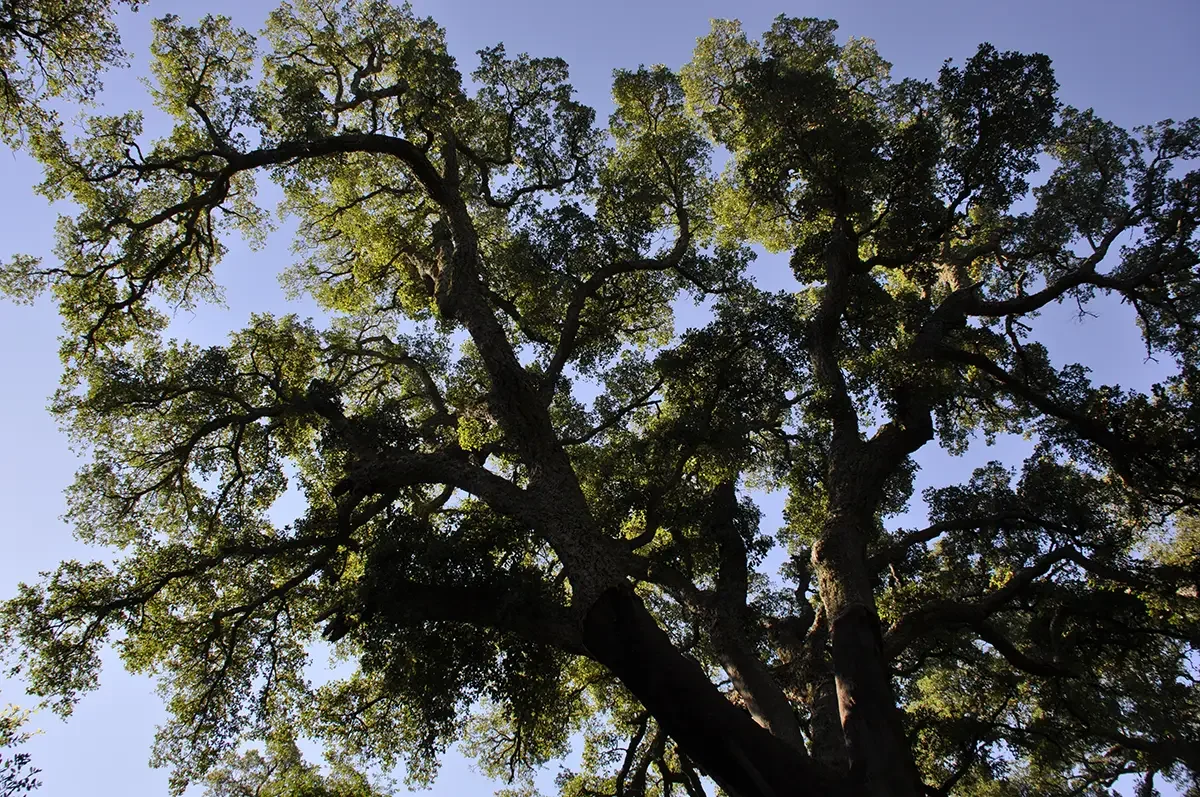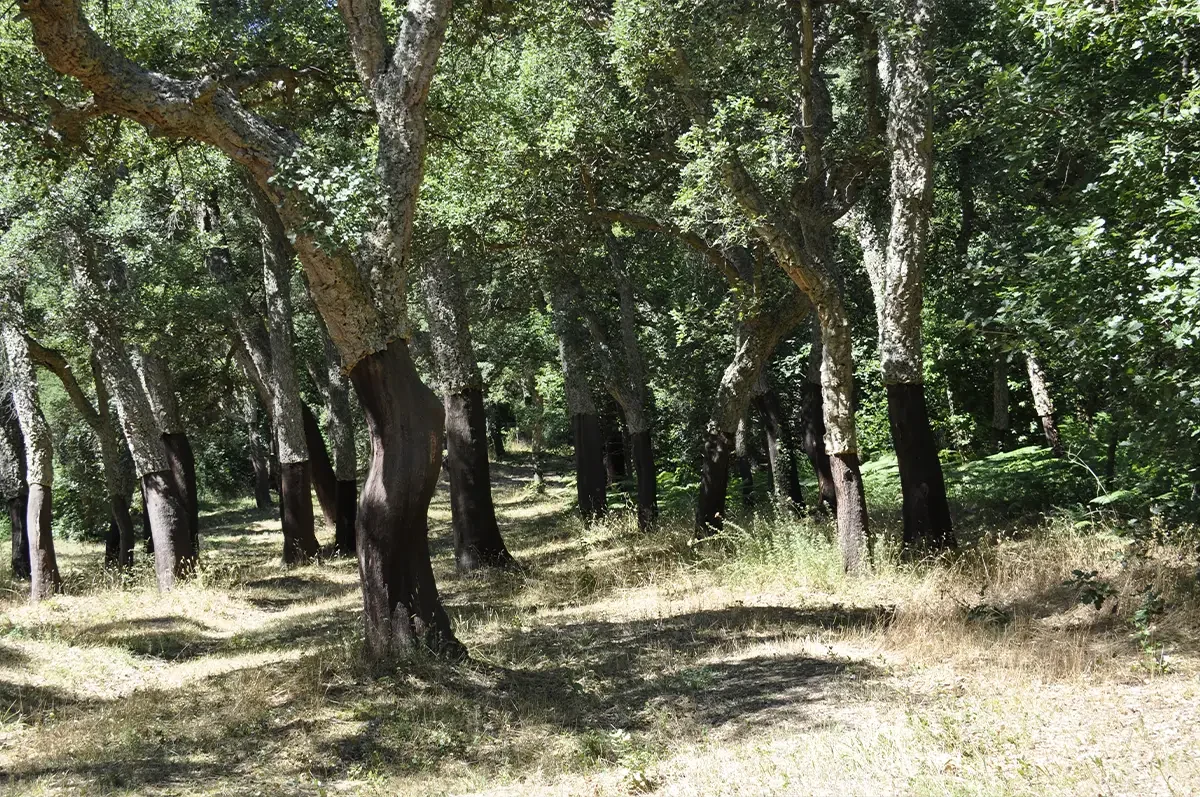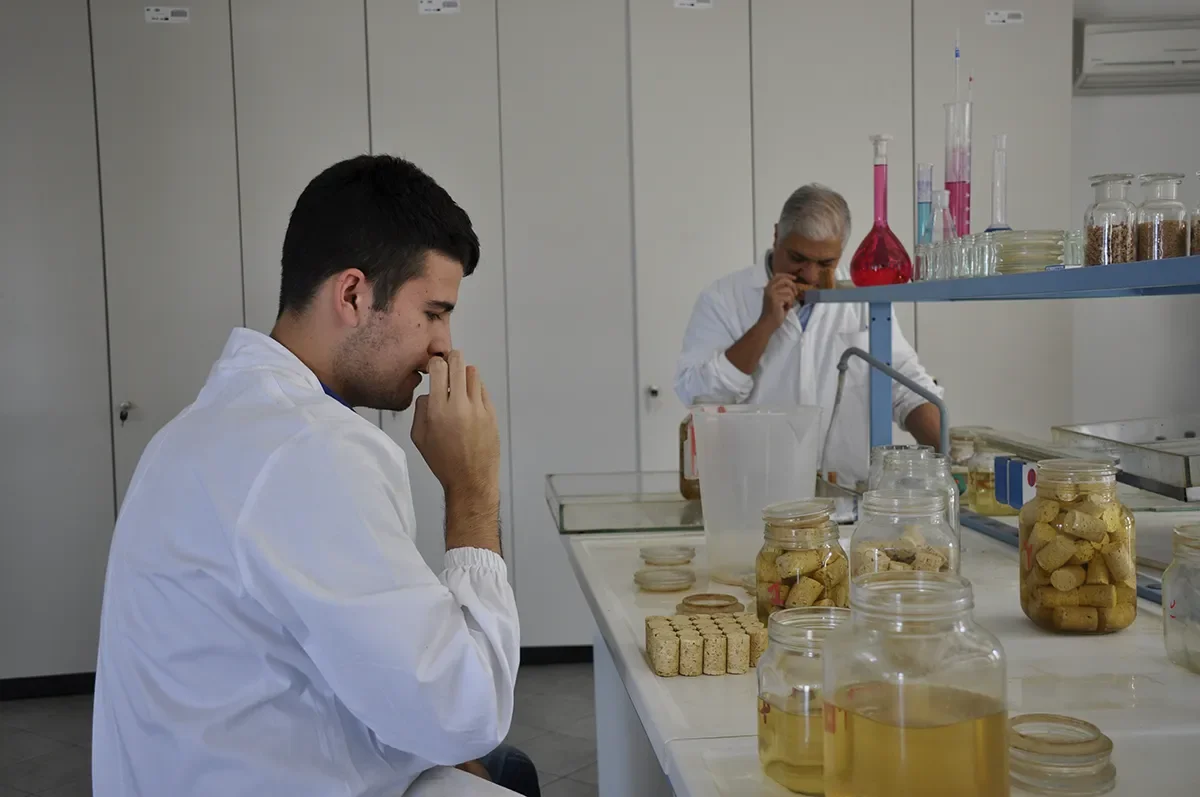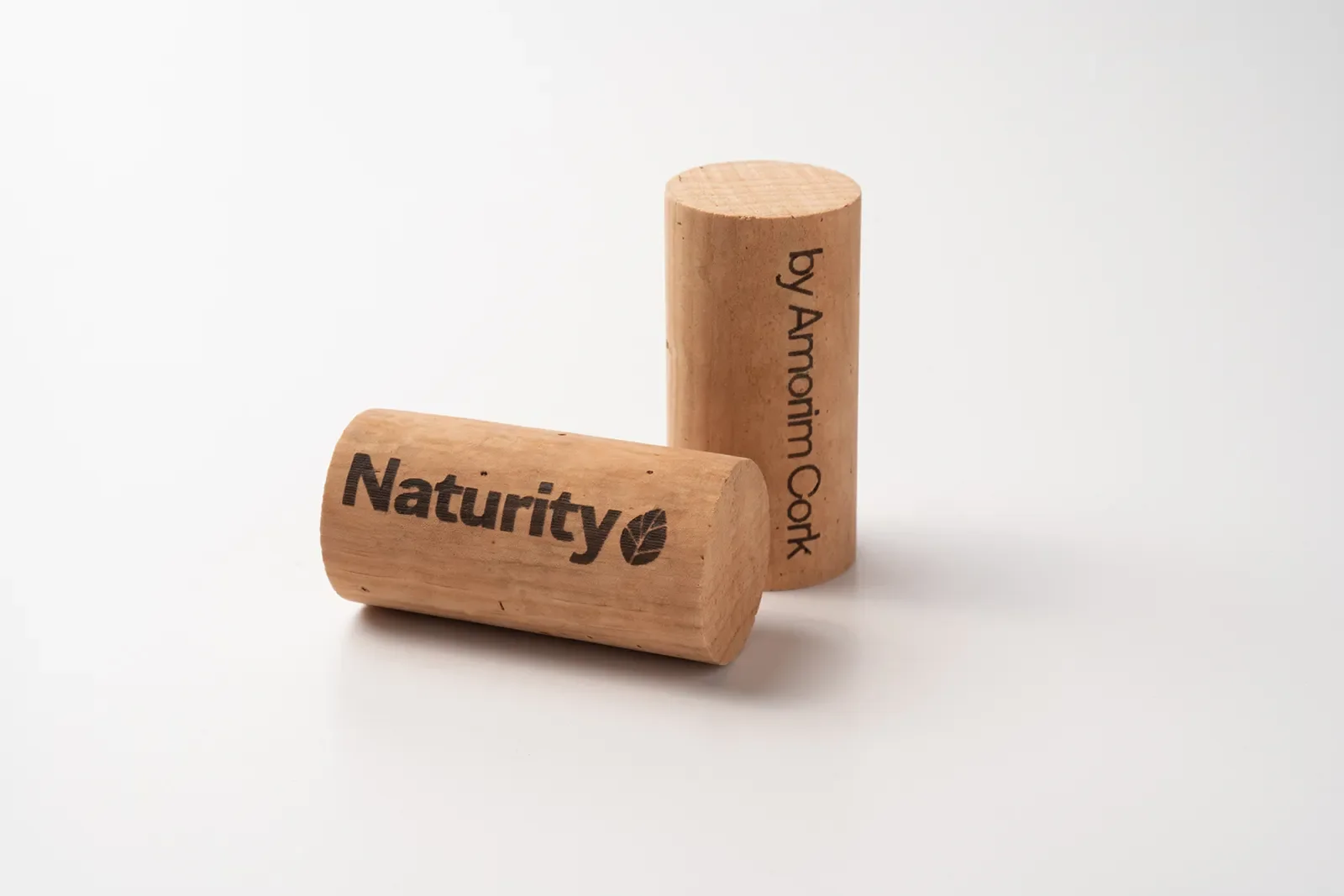How natural is natural cork? Renewable raw material meets high-tech
Original article by wein.plus by Raffaella Usai
Image: Raffaella Usai
The manufacturers of natural cork advertise with the image of naturalness. But how natural is it really? And how sustainable is its production? Raffaella Usai asked.
The evergreen, gnarled cork oaks stand with stoic majesty in the Mediterranean scrub. When the sun is high in the sky and radiates its bright light, the trees glow in mysterious shades of green. The landscape of my home in north-east Sardinia has enchanted me since I was a child.
Cork oak forests bind 14 million tonnes of CO₂ worldwide every year. Image: Raffaella Usai
I admit: I like natural corks. Not because of the characteristic pop when opening the wine bottle or because I am convinced that they are the best closure per se. But because they are made from a renewable raw material and because cork oak forests protect the landscapes in the Mediterranean region. They prevent desertification, soil erosion and the loss of biodiversity.
A cork oak whose bark is regularly harvested binds three times as much CO₂ as an unused cork oak. And if cork oaks lose their economic value, they will disappear from the landscape, warns the environmental organisation WWF. It is cork production that keeps the cork oak forests and their ecosystem alive.
But regardless of the positive properties of cork oaks for the ecosystem, I ask myself: how sustainable and natural is cork as a closure really?
Idyll versus reality
Peeled cork oaks bind three times as much CO₂ as unused cork oaks. Image: Raffaella Usai
At first glance, natural cork is a prime example of a sustainable raw material. This is because the bark of the cork oak is harvested by hand every nine to twelve years and processed into cork stoppers and cork products with virtually no waste. The harvest does not harm the tree, on the contrary: the bark regenerates after peeling. A cork oak lives for an average of 300 years—half of its life can be used commercially.
According to the German Cork Association, 70 per cent of the cork industry's added value comes from corks for the wine industry. But how much energy, technology and chemicals are required to produce a high-quality TCA-free cork stopper? Can we still speak of "natural"?
Professor Rainer Jung from Hochschule Geisenheim University has been working on wine closures for 30 years and supervises various projects with cork producers. He clarifies: "Before we talk about naturalness, we have to differentiate between pure natural cork or granulated cork and other technical cork-based closures."
Let's stay with pure natural cork and its production. The cork bark pieces are first boiled in hot water. They are then cut into strips and the corks are punched out. Depending on the customer's wishes, they are then bleached with hydrogen peroxide. This is the first contact with a chemical—with only cosmetic benefits.
"Not everyone wants brightened corks, I personally prefer the natural character, but that's up to each winery to decide. In the past, this was done with chlorine-based agents, but this is no longer done today," explains Rainer Jung. Corks that are not bleached are disinfected in a bath of citric acid. Some manufacturers also use ozone to kill microorganisms.
None of these substances remain in the cork later, Jung reassures me. "Peroxide in particular would cause a lot of damage in contact with the wine, so the manufacturers meticulously check in the laboratory that everything has evaporated." After cleaning, however, the corks are not yet ready for use. They lack the coating that ensures the cork slides smoothly when corking the bottles and makes it easier to remove the cork later. The coating usually consists of silicone oil (polydimethylsiloxane), which is applied in a thin layer. The food additive is considered non-toxic and chemically stable and is well tolerated by the human body. Only then are the corks packed in 1000-piece bags with the addition of SO₂ and vacuum-sealed.
The initial conclusion: even if no chemically harmful residues can be found in the corks, a wide variety of agents are used in the production process that put the word "natural" into perspective.
But research does not stand still, Rainer Jung tells me. For example, a project is underway in Geisenheim with the Portuguese company Amorim in which beeswax is used instead of silicone oil for coating. "It works very well," explains Jung.
Robots, AI and precision technology
At Sugherificio Molinas, natural cork stoppers are randomly tested by sensory experts. Image: Raffaella Usai
One of the biggest criticisms levelled at natural cork to date is the possible contamination with TCA (trichloroanisole). This substance causes the infamous "cork taint": mouldy, musty, wine undrinkable. In order to get the problem under control, the cork industry has invested in innovative anti-TCA processes, precise quality control and better forest management over the past 25 years.
This is because the management of cork oaks is already of great importance in reducing the risk of TCA developing. "It is important to regularly remove the undergrowth to prevent the colonisation of bark fungi and to avoid using pesticides," emphasises Giuseppe Molinas from Sugherificio Molinas in Sardinia. The Italian producer's sustainability strategy is based on FSC-certified forests. Clear-cutting and the use of chemicals are prohibited.
Above all, however, much has been modernised in production itself. "The companies have developed different physical processes. Pressure, heat and steam are used to separate the TCA molecules from the cell structure of the cork," says Rainer Jung. Understandable, but a pity: manufacturers are not very transparent when it comes to communication, they want to protect their production processes from the competition as much as possible.
Gas chromatographs, which reliably detect sensorically critical compounds in the trace range, are no longer the only means of detecting TCA. Robot-assisted inspection lines, machine learning algorithms and precision technology are also used.
It is not entirely clear how high the risk of catching TCA-contaminated corks is in the end. "There are no representative surveys on the TCA risk. There never have been. There used to be talk of one to five per cent, but that didn't correspond to reality. Some cork manufacturers never had any problems, then again there were cases where 20 per cent were affected. However, I have noticed that TCA complaints are virtually non-existent now," reports Rainer Jung.
Heterogeneous raw material must be standardised
The second reason why many winegrowers are now abandoning natural corks is their dubious homogeneity. The Portuguese company MA Silva has developed the "Bionic Eye" process, which uses ultra-sensitive imaging and AI to inspect every single cork. This rejects faulty stoppers with an accuracy of 99.5 per cent, ensuring batch homogeneity and reducing waste.
Cork Supply, also based in Portugal, uses patented technology for its Legacy cork stopper. According to the company, "AI and electromagnetic imaging are used to analyse the internal structure of each cork for consistency and predict oxygen permeability." Today, the industry goes to great lengths to achieve a standardised product.
The Naturity cork stopper from Amorim has an amazingly good CO₂ footprint. Image: Amorim
CO₂ balance: unbeatable!
Even though there is a lot of technology behind a natural cork today, it is unbeatable in terms of its carbon footprint. "No other material can keep up," emphasises Rainer Jung. Tanja Lauterbach is the German Head of Marketing at global market leader Amorim. The Portuguese company offers many different corks. "A detailed calculation of the CO₂ footprint is available for each of our products," says Lauterbach. The data is certified by the independent Portuguese organisation Apcer.
The Naturity cork stopper from Amorim has an amazingly good CO₂ footprint.Amorim
Amorim follows the "cradle-to-gate" approach, which refers to the manufacturing process of a product, from the extraction of raw materials to the point at which it leaves the factory. The Amorim "Naturity" cork performs best with a negative CO₂ footprint of –56.4 CO₂ eq per 1,000 corks. For all those who, like me, have little idea: 1,000 such cork stoppers save 56.4 kg of CO₂—that corresponds to the CO₂ emissions of a car journey of around 450 kilometres or 11,000 charges of a smartphone.
Cork manufacturers such as Cork Supply, Sugherificio Molinas and others also advertise a neutral or even negative carbon footprint for their products. The only flaw: all the facts and figures about production, sustainability and carbon footprints come from the companies themselves and are only checked by certification organisations in a second step. Prof Jung also confirms that there are no independent surveys of the cork industry's carbon footprint.
Industrially refined image carrier
The natural cork stopper is still an image carrier, especially for fine wines. "I'm also currently seeing a certain trend towards natural cork among students, as it still exudes a sense of value that no other closure conveys. Young people simply haven't had many bad experiences with cork stoppers," says Rainer Jung about the openness of his Geisenheim students.
Natural cork therefore remains a fascinating material with deep ecological roots. However, it is only as natural as an industrially refined natural material can be. Many of the methods used in its production are now based on physical processes - but chemical agents are still used for cleaning, bleaching and disinfection. The industry is endeavouring to reduce the use of chemicals through new technologies, precision engineering and AI. Nevertheless, the advertising claim "100 per cent natural" is not tenable.
"Cork is a natural product and 100 per cent recyclable. That is its added value. But it is also clear that no cork stopper is untreated," says Tanja Lauterbach from Amorim. The best corks today are a combination of renewable raw material, chemical cleaning and high-tech processes. In terms of environmental performance, corks are still way ahead of screw caps, glass and plastic corks.





